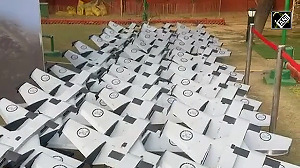80% of the surveyed districts did not show any change in migration, reports Sanjeeb Mukherjee.

The Mahatma Gandhi National Rural Employment Guarantee Act (MNREGA) has succeeded in creating livelihood assets but has not met one of its main objectives -- ending migration.
According to a survey conducted by the Institute of Economic Growth (IEG), almost 78 per cent of households covered reported an increase in water table after building conservation structures through the MGNREGA.
There was an 11 per cent increase in rural incomes. But around 80 per cent of the surveyed districts did not show any change in migration. Only 20 per cent districts reported a dip in migration, the survey showed.
In all the 30 districts the survey covered, around 18 per cent beneficiary households of the natural resource management (NRM) component under MGNREGA reported migration with a range varying from 8 per cent in Mahendergarh (Haryana) to 40 per cent in Nainital (Uttaranchal).
“The percentage of migrating households fell in 6 of the 30 districts covered in the survey, the highest being 10 per cent in Jalna in Maharashtra.
"In 24 districts, the percentage of migrating households did not change,” the survey said.
The study was conducted in 21 states spread over 14 agro-climatic zones. Around 1,200 (40 from each district) beneficiary households were given the questionnaire.
One of the objectives of the rural job guarantee scheme was stopping or lowering migration from rural areas for jobs.
The survey found instances of a delay in wage payment beyond the mandatory 15 days in some cases.
But the delay was more acute in payment of material costs than wages. Around 75 per cent of the material cost is from the Centre and the rest from states.
The delay in this count could also be because of states' failure to release their share of material expenditure, the survey said.
In many regions, the average wage earned by an MGNREGA worker was lower than the market rate, while in some it was even lower than the minimum wage.
The selection of districts for the survey was based on NRM expenditure per MGNREGA worker.
The NRM component includes work related to soil and water conservation, groundwater recharge, irrigation-related works and drainage-related works, etc.
Of more than 150 types of works permitted under MGNREGA, almost 100 are related to natural resource management.
The survey also showed that cereal productivity increased by 11.5 per cent and vegetable productivity rose by 32.3 per cent in households in areas where such assets were created under MGNREGA.
Around 76 per cent of the households surveyed said water conservation and other such kind of assets created were of good quality.
Around 73 per cent of the respondents said they themselves were actively involved in the maintenance of assets created under MGNREGA on individual land.
Photograph: Krishnendu Halder/Reuters.











